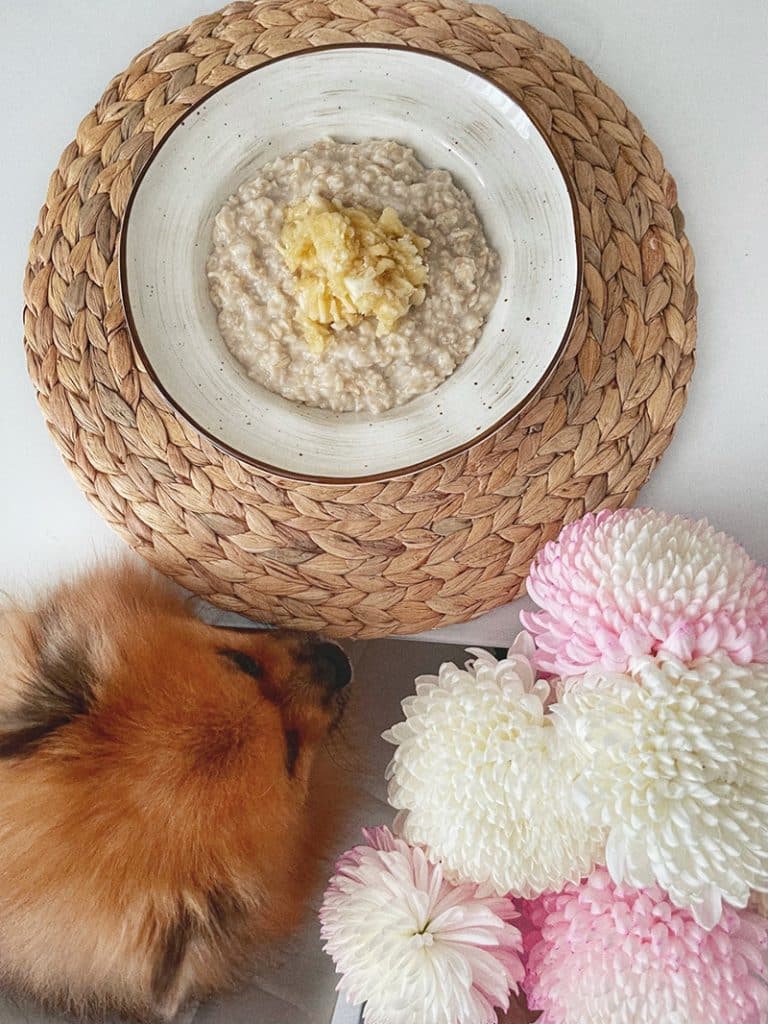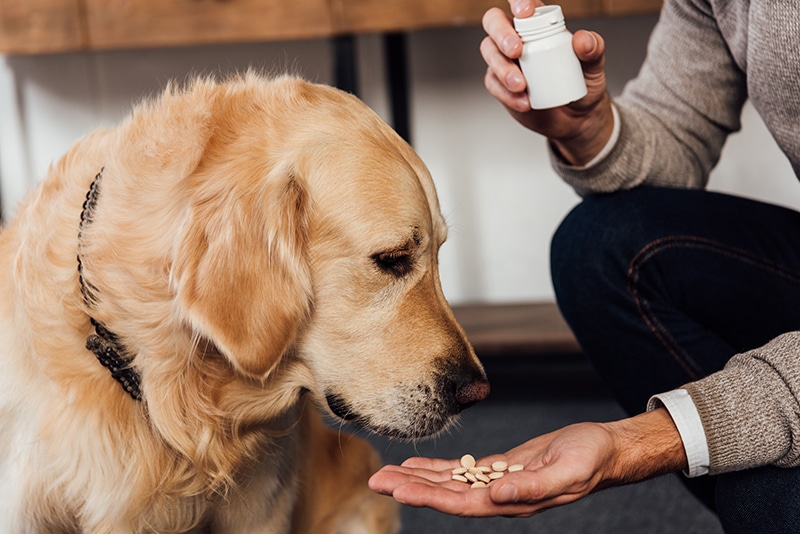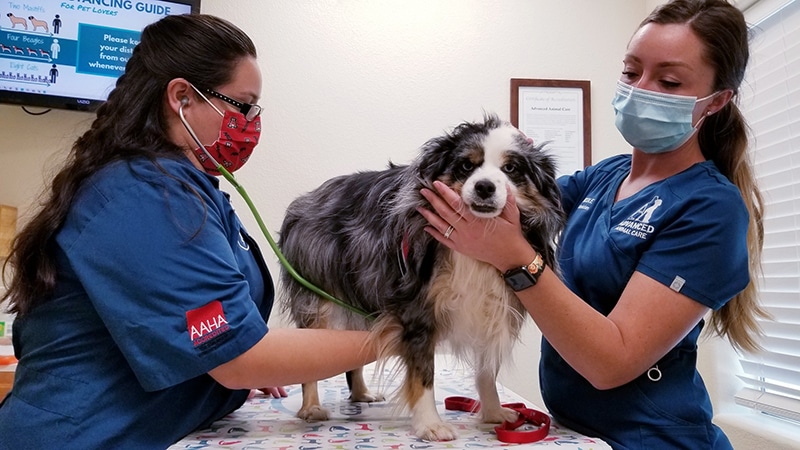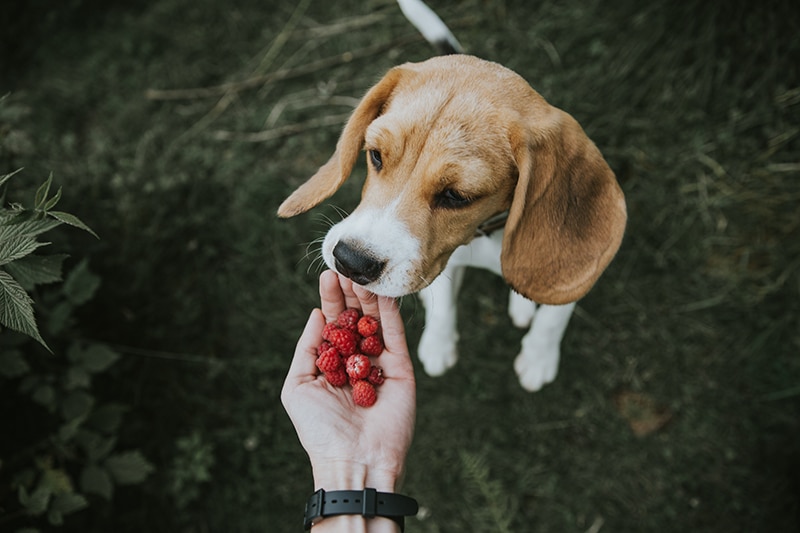You may have heard that it’s okay to express your dog’s anal glands manually if they’re impacted, but it’s not advisable without veterinary supervision. Dogs should be able to empty their sacs naturally. Sometimes we can help the process by adding some high-fiber foods to their diet.
Impacted anal glands are a common occurrence in most canine practices, and mine was no different. When pet parents brought their pooches in because they had anal gland problems, I never advised them to manually express the sacs. This practice can damage the tissue around the rectum and cause repeated issues. Instead, I focused on teaching my clients how diet and lifestyle changes could help their pups achieve firmer stools and natural anal gland expression.
In the sections below, I will share some top fruits, vegetables, and other foods that can add fiber to your dog’s diet.
These materials help to absorb extra fluid in the intestine and add bulk to the poop. After that, I will share several other ways that you can help your pooch express her glands naturally.
Some methods involve diet and supplements while others focus on lifestyle and supportive measures. Finally, I’ll share signs of anal gland problems and why it’s important to contact your veterinarian if you think your dog has a problem.
Let’s get started.
High Fiber Foods That Help With Anal Gland Expression

There are several high-fiber foods that can help add bulk to your dog’s poop and encourage natural anal gland expression. While the list below is not all-inclusive, it contains ten options that you can add to your pal’s diet as a snack or dinner topper to boost daily fiber intake.
Pumpkin
Pumpkin is an excellent natural source of fiber that’s soluble and insoluble. This tasty food also contains phytonutrients, vitamin E, and potassium. Whether you use canned plain pumpkin (not pumpkin pie mix) or fresh, steamed pumpkin, you can add it to your pal’s kibble to add bulk to his stool.
Many commercial dog foods that help with Anal Gland problems contain pumpkin as one of their primary high fiber ingredients.
You may add up to about 1 teaspoon for 10 pounds of body weight. It’s also safe to feed your pooch unsalted pumpkin seeds as a high fiber treat.
Banana
Also high in fiber and other nutrients, bananas are another food you can add to Fido’s diet to help firm up the stool. They include B and C vitamins, potassium, and magnesium, which are essential nutrients.
You can feed some peeled banana slices to your pup after a walk, or mash banana and pack it in a kong. Because this fruit is higher in sugar, feed it in moderation.
Sweet Potato
Low in fat and rich in essential vitamins A and C, calcium, and omega fatty acids, sweet potatoes are another high-fiber food that you can give to your dog in moderation. The omega fatty acids in this tuber help to reduce inflammation that can cause anal gland impactions while the high fiber content helps to firm up the stool.
The best way to feed sweet potatoes is steamed and mashed. Skin the potatoes and dice into small pieces then steam or cook in the microwave before mashing. Like pumpkin, add about 1 teaspoon per 10 pounds of body weight to your pal’s food.
Apple
Apples are packed with fiber and pectin which helps to absorb moisture and firm up stools. A delicious treat, these fruits also add antioxidants and vitamins A and C. Before you feed apples to your pooch, be sure to remove the core and seeds. You can easily treat your pooch with slices or pieces of fresh or frozen apple as a refreshing snack.
Green Beans
Rich in dietary fiber and vitamins A and C, green beans can help moderate inflammation and add bulk to your dog’s poop. They also have essential minerals and some omega fatty acids. You can feed your pooch fresh or frozen green beans.
If using raw beans, it’s best to puree the vegetable to improve digestibility. Otherwise, you can steam the green beans (do not season), chip them up, and add them to your pal’s kibble.
Carrots
Packed with fiber and beta-carotene, carrots are a favored crunchy treat for many dogs. They’re low in calories and can help to firm up the stool and give your pooch a feeling of fullness.
Offer cut-up pieces of raw baby carrots as an afternoon treat, or grind them up and mix with dinner. If your pup has a hard time digesting the vegetable, you can lightly steam the carrots.
Broccoli
Broccoli is rich in phytonutrients and fiber. It’s also an excellent source of Vitamins A, C, and D, and some essential minerals. You’ll need to feed this vegetable in small portions and observe your furbaby, as the florets contain isothiocyanates that can irritate the stomach in some dogs.
When you feed broccoli to your pooch, it’s best to blend or mulch it raw and add it to Fido’s dinner. If your pup can’t handle the vegetable raw, you can lightly steam it before blending it. Start with about 1 tsp for each pound of body weight to see how your pup tolerates it.
Leafy Greens/Lettuce
Lettuce is mostly fiber and water, both of which are helpful nutrients for dogs with anal gland issues. Some varieties like kale and spinach include nutrients such as vitamin C and iron. When feeding lettuce, make sure you chop it up to make it more digestible for your pooch. You can mix this in with your pal’s dinner. Avoid feeding leftover salad from the table as that may contain onions, which can be deadly for dogs.
Strawberries/Blueberries
Fresh berries, including strawberries and blueberries, are packed with antioxidants and fiber. They make a tasty addition to your pup’s meals, or you can feed them as a special treat.
Remember to keep them in moderation because they also contain sugar. You can easily rinse and serve these tasty tidbits or freeze them for a refreshing summer treat.
Oatmeal
An excellent high-fiber food, oatmeal can help promote regular bowel movements and firmer stools. The soluble fiber works to absorb excess liquid in the gut and adds bulk to the stool The firmer poops apply appropriate pressure on the anal sacs to express the gland’s contents.
When feeding your pooch oatmeal, do not use quick oats, and cook with water. Then you can add about 1 tablespoon of cooked oatmeal for every 20 pounds of body weight to Fido’s food.
Kelp
Wait, isn’t kelp seaweed? It is, and it’s also a potent superfood. This substance offers a rich source of fiber and several essential nutrients including omega fatty acids, iodine, and iron. This material is frequently used as a bulk-forming laxative. The nutrients in kelp can help combat inflammation and promote firmer stools. This combination of effects makes it easier for your pooch to naturally express his anal glands when he poops.
You can add powdered kelp to your dog’s kibble, raw meals, or wet food at a rate of about ¼ teaspoon per 10 pounds of body weight each day.
Ground FlaxSeed
Flaxseed is a potent source of antioxidants, fiber, and omega fatty acids. With this combination of nutrients, ground flaxseed not only promotes a healthy stool, but it can also help fight inflammation that can contribute to anal gland problems.
You can sprinkle some flaxseed meal over your pooch’s dinner or mix it with peanut butter (with no xylitol) to make treat balls.
Brown Rice
Cooked or steamed plain brown rice can add fiber and vital nutrients to your dog’s diet. This whole grain is packed with B vitamins, vitamin E, vitamin K, and essential minerals like iron and zinc. Because it’s also carbohydrate-rich, you’ll want to feed brown rice in controlled quantities.
Small dogs should have around a tablespoon and large dogs no more than ¼ cup mixed with dinner. Never feed uncooked rice.
Beets/Beet Pulp
Beets are packed with fiber and nutrients. As a matter of fact, many commercial dog foods add beet pulp to the formula for extra fiber. These roots are loaded with vitamin C, calcium, potassium, iron, zinc, and more. They’re safe to feed raw or cooked, as long as you don’t add any salt or other seasonings.
Do not feed pickled or canned beets because of the added sodium content. The best way to prepare beets for your dog is lightly steamed or boiled. Be sure to cut them into small pieces to prevent choking.
You can also add raw, shredded beetroot to your pal’s dinner. Start with small portions and monitor your dog because some pups can have an allergic reaction to beets.
One caution, if you have a pooch prone to kidney or bladder stones, beets may not be the best option. They’re high in sodium and contain oxalates.
Other Ways to Help Dogs Express Their Anal Glands Naturally

If your dog is prone to anal gland issues, you can do more than feed high-fiber foods to add bulk to the stool. Whether you address your dog’s problems by diet, lifestyle, or special care, below you will find a list of eight ways you may be able to help Fido express his glands naturally.
Add a Fiber Supplement
If your dog’s diet doesn’t have enough fiber to encourage firm stools, you can add a fiber supplement. Soluble materials like psyllium help absorb excess liquid in the intestines, and this leads to a firmer stool.
Be careful about the amount of fiber you add to your dog’s diet especially if they have blood around the anus or seem to have pain during defecation. Fiber supplementation is particularly helpful when your pooch first develops anal gland issues.
Give Your Dog High-Fiber Treats
There are some excellent high-fiber chew treats on the market that can increase your pup’s daily fiber intake.
Options like Glandex provide your pooch with soluble fiber from ingredients such as pumpkin seed and pectin and may include probiotics to encourage healthy digestion. With a few tasty tidbits a day, you can boost your furbaby’s fiber to help produce firm stools.
Add Probiotics to the Diet
One way you can assist your pooch with anal gland issues is by adding probiotic bacteria to their diet. These microorganisms help replenish your pal’s normal gut flora and promote proper digestion.
By soothing the gut and aiding in proper digestion, probiotics can help ensure normal, firm stools that will apply appropriate pressure on the anal sacs during defecation.
Feed a Raw Diet
Regular commercial dog foods tend to promote softer or mushy stools in some dogs, and these poops will not help with natural anal gland expression. One natural alternative to paying for high fiber kibble is to feed your pooch a raw diet that includes bone content. The bones will dissolve during digestion and cause firmer poops that push against the anal glands when your dog goes potty.
Exercise Your Dog
If your pooch is having anal gland problems, try increasing exercise. Take your furbaby for longer or extra walks every day. You can also increase playtime or slowly add more vigorous activity.
Exercise helps to build muscle tone in the abdominal and rectal muscles so that your dog can put more pressure on the anal glands during defection. Regular activity also helps stimulate more frequent bowel movements.
Put Fido on a Diet
Excess weight can contribute to anal gland impactions. The added fat in the rectal area surrounds the anal glands and makes emptying harder. If your pooch is overweight, put him on a reducing diet to help him reach and maintain a healthy body weight.
Add Moisture
While it may seem counterintuitive, adding moisture to your dog’s diet may help with anal gland issues. Some canines will not consume enough water from their dish, so they need added liquid.
If a pooch doesn’t get enough water, she may become dehydrated. Dehydration can interfere with normal digestion and may cause thicker anal gland secretions.
By adding water to kibble or using canned food, you can increase your pal’s daily water intake, and that encourages regular bowel movements as well as more manageable anal sac fluids.
Apply a Warm Compress
If your pooch has an anal gland impaction, you can help soothe the area and open up the ducts by applying a warm compress under the tail.
Soak a clean washcloth in a solution of warm water and 1-2 teaspoons of Epsom salts or witch hazel and apply to the anal region for about 10 minutes, twice a day. Always use a fresh washcloth and wear gloves.
When Should I Consult With a Vet?

Any time you suspect your dog may have anal gland issues, you should consult with your veterinarian. He or she can examine your pooch, determine if there are any underlying conditions, and recommend the right course of treatment for your furbaby.
Because anal glands can point to more serious concerns such as a tumor or rectal fistulas, you should never self-diagnose and treat your pooch. You should not attempt to express your dog’s anal glands yourself because you can damage the tissue and cause your pup unnecessary pain.
So, how can you tell if your pup is having problems with her anal glands? There are some common symptoms that signal trouble with these sacs.
- Scooting – Dogs that have trouble expressing their anal glands may scoot their butts along the ground to try to force the oily excretions out.
- Excessive biting or licking – Dogs may lick or bite the area around their anus to try to squeeze the liquid from their anal sacs. Some pups may also lick or chew their paws if they’re feeling discomfort from impacted anal sacs, and some may chase their tails.
- Straining or painful defecation – If a pup is having difficulty expressing his anal glands, he may strain or cry when pooping because it’s painful.
- Foul odor – When anal glands become impacted, the liquid festers and becomes putrid. If you notice a foul odor near your dog’s rear end that does not resolve with bathing, it may be from the anal glands.
- Swelling and redness – Sometimes impacted anal glands trigger inflammation and swelling around the tail area. The area will be painful for your pooch. If your dog suffers from chronic impactions, the skin under the tail may become thickened and hard.
- Brownish-red discharge – If you notice brownish-red spotting where your pooch has been sitting or discharges around the anal area, they’re likely from anal glands.
- Abscesses – Abscesses around the anus with or without pussy drainage are signs of impacted or ruptured anal glands.
The Final Woof

Most dogs express their own anal glands naturally. If you have a pooch that struggles with anal gland issues, adding some high fiber foods to the diet may provide added support to help firm up the stools. There are several fruits, vegetables, and whole grains or seeds that offer rich sources of fiber and other essential nutrients. In addition to high-fiber foods, there are several other ways that you can help your pup naturally express his anal glands.
If you notice warning signs of anal gland issues, do not attempt to express your dog’s anal sacs manually. Consult with your veterinarian before taking any action. That way you can rule out other serious health issues and determine the best course of action.
The bottom line is that you can prevent anal gland problems with diet and lifestyle. Feed a proper diet that includes higher fiber, balanced nutrition, and appropriate supplements to promote healthy digestion and firm poop. In addition to diet, you should also ensure that your pup gets adequate exercise to stimulate regular bowel movements and build strong abdominal and rectal muscles.



Hello,
When mentioned pumpkin and sweet potato fiber for anal glands, can this also include the squash family – butternut/buttercup?
Thanking you,
Hi Kristine,
Yes, your dog can have butternut squash flesh.
Edele
Hi,can u recommend specific supplements and or foods for a pug to eat for healthy anal glands? and will the glands empty themselves or do I get a vet to do it?
many thanks. I appreciate your time and effort very much.
my dog is uncomfortable all the time and he’s a good dog, named Loyd. I’m Mike, I have a mental disability, but the dog helps me bigtime I need to help him as well.
Your pal Mike Persan
Hi Michael,
Glandex is a great supplement that I give my own dog when she has problems with her anal sacs.
Some pets may be able to express their own glands with the help of the supplement while others will still need veterinary assistance, but this will vary with each dog.
Your vet will be able to advise you on Lloyd’s specific needs.
You can read more here:
https://fluentwoof.com/glandex-for-dogs-review/
What type of Yoghurt is good to give a small dog with anal gland issues , She often scoots along the carpet .
Hi Mrs. Julie Daniel,
Yoghurt isn’t a great option for dogs with anal gland issues as our pooch friends can’t digest it properly and it can actually give sensitive pup’s diarrhea which is the opposite of what we want for our pups with anal gland issues. It would be better to try pumpkin for a pooch with anal gland issues.
Good morning
I am enjoying all of the information you have given! I am a new fuzzy mom and I guess my real confusion is my vet explained when my girl has a hard bm it expresses the anal glands naturally. Which I totally understand.
Pumpkin tends to make the stool soft, and some of the side effects for the gland supplements are soft stool and or diarrhea.
So how does pumpkin help anal glands if it makes the stool soft? I understand it’s fiber, but I do not understand how it helps the glands?
My pups are also on purina pro plan for sensitive stomach and skin. In reading up on anal gland issues since it can stem from digestion, how do I know if this food is helping?
I’m considering purchasing gland supplements. However along with that I was reading probiotics are also encouraged to go along .
So my questions are
1) how do I know if the regular food is no longer useful since both dogs are licking themselves alot?
2) if I purchase the anal gland supplement can I still purchase probiotics?
3) if I purchase both will it be overkill because of the dog food with probiotics?
4) is there any guide to help you know how much probiotics can be consumed if it’s in each product you have?
Signed confused mom!
Hi Michele,
Thank you for your patience. Some of the notes about Pumpkin to help you better understand. I hope these help:
Pumpkin contains both soluble and insoluble fiber. The insoluble component bulks your pet’s feces which puts pressure on the sacs and allows your pet to express them.
Pumpkin also keeps stools at a normal consistency, not so hard as to be difficult or painful to pass.
While diarrhea can be possible with pumpkin this is usually temporary and resolves itself if you reduce the amount of pumpkin offered.
It can be prevented by starting with small amounts of pumpkin initially and slowly increase the amount to achieve the desired results. To answer the questions:
1. To find out if the licking is due to anal gland issues you can have your veterinarian express their anal glands and if they are overly full or inflamed then your veterinarian will be able to advise you further about your pet’s nutritional needs. This may require a change in food or may simply be adding in some supplements.
2. Yes, you can purchase a separate probiotic or prebiotic alongside the anal gland supplement of your choice. Some supplements contain prebiotic too.
I recommend Glandex as I use it for my own dog and have definitely found they help her. (Read more here: https://fluentwoof.com/glandex-for-dogs-review/ )
3. If your dog food and the supplement both contain probiotic, then there’s not need to purchase a separate probiotic.
4. There’s no established recommended daily amount (RDA) of probiotic for dogs currently though research is ongoing into this field.
Yes, you can certainly incorporate some pumpkin into your pet’s homemade treats. Just make sure it’s plain pumpkin and doesn’t contain sugars nor artificial sweeteners or spices.
Dr.Edele Grey
Dear Dr.
Could you please tell me how long it takes to full up the anal glands. I know each dog is different, but I just had my 1-year-old Japanese Chin seen by our vet who did express his glands and he is still scouting and chasing his tail. He is now on adult food which I hope will help because the puppy food made his stools too soft & on Benefiber 1/4 tsp. per vet. I really would like to know how long does it take once expressed to be back on this hamster wheel of full glands is it immediately once they eat, a day, a few days??/ Thank you so much! Andy
Hi Andrea,
Every dog is different but the shortest frequency should be monthly.
Often after having their glands your dog may still scoot their bum for a few days due to discomfort and inflammation.
This is nothing to worry about and should resolve in a couple of days
Hi
I’m planning to try to naturally help my dog express her glands through diet change, adding sweet potato, apples, carrots as the article suggests and warm compresses.
How often should I be giving sweet potatoes/carrots in her food (she eats 2xs a day)? How much apple a day?
I am trying to avoid too much and causing diarrhea. Also, how soon do you think I will see positive results (less scorching/smell gone)?
Hoping to avoid the vet as I don’t want her glands damaged and future issues
Thank you for your article! I was so happy to find information on treating my pup more naturally and gently
Appreciate your help
Amanda
Hi Amanda,
If your pets anal glands are full then they likely need to be expressed by your veterinarian.
You can work up to giving your pet a small amount of pumpkin/carrot/sweet potato daily but start with every 3-4 days and see how they respond.
How soon you see results will vary with each pet.
I have an older Beagle rescue, but not much is known of her history. She has had scooting issues for months now. Had her glands expressed twice recently and she is now scooting again. She weighs 32 lbs and I think she should be less and we are working on it. but it is slow going. I am open to using other modalities to help with the gland issues. How much pumpkin should she have daily at her current weight and can I give her psyllium in her food? Thank you for your help with this, it is very much appreciated.